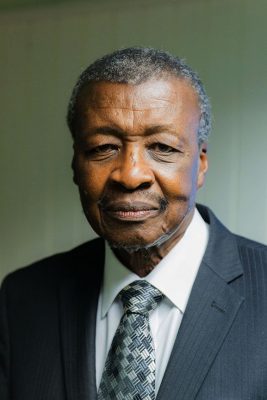
January 19 2019
Attorney General (AG) Basil Williams SC yesterday submitted to the High Court that parliamentary precedent and practice establish that an “absolute majority” of 34 or more votes of the elected members of the National Assembly were needed for the government to be defeated on the recent no-confidence motion
Williams also argues that the provisions set out in Articles 106(6) and 106(7) of the Constitution, which provide for the holding of new elections within 90 days upon the success of a no-confidence motion, are inconsistent with Article 70(3), which provide for a five-year term for the government and therefore the resolution is void.
“The quintessential fact is that there has been an error in the manner of the calculation of the number of votes needed for a No Confidence Motion, and this error carried over into the purported pronouncement by the Speaker that the vote was carried. The ineluctable conclusion is that the vote was improper and unconstitutional,” Williams says in his written arguments, which were submitted yesterday in keeping with timelines set by Chief Justice Roxane George-Wiltshire.

Rebuttal submissions are to be served and filed on Monday, while oral arguments will be made next Friday at 1.30pm.
With his application, which lists Speaker of the National Assembly Dr. Barton Scotland and Opposition Leader Bharrat Jagdeo as the respondents, Williams has asked the court for orders to stay the enforcement of the motion and enable President David Granger and all his ministers to remain in office. In addition, Williams has asked the court for a conservatory order to preserve the status quo ante that the President and all Ministers of the Government remain in office until the hearing and determination of questions surrounding the legality of the vote.
Scotland declared that the motion was carried after then government Member of Parliament (MP) Charrandass Persaud voted with the opposition. Among the seven questions Williams has asked the court to determine is whether the motion upon a division vote of 33 to 32 MPs was validly passed as it is his contention that 34 votes were needed.
Through Deputy Solicitor General Deborah Kumar, Williams has outlined four legal issues for the court to take into consideration. These are whether 33 votes in favour of the motion of no-confidence amounted to a majority of all elected members in accordance with Article 106 (6) of the Constitution; whether the Resolution is constitutional and effective and passed in accordance with Article 106 (6) of the Constitution; whether the amendment that caters for Articles 106(6) and 106(7) is constitutional and not inconsistent with Article 70 of the Constitution; and whether the Speaker’s ruling on the vote can be quashed by the Courts.
‘Vote of a majority’
With regards to whether 33 is the majority, the AG insists that the Speaker miscalculated. “In order for the Government to be defeated on a vote of confidence, 34 or more votes of all the elected members in favour of the motion was required instead of 33. This assertion is grounded in established parliamentary precedent and practice and case law in the Commonwealth,” he submitted.
He cites Article 106 (6), which states that “The Cabinet including the President shall resign if the Government is defeated by the vote of a majority of all the elected members of the National Assembly on a vote of confidence.”
According to the AG, the constitutional requirement for voting on a motion of no-confidence is distinct from voting on the passage of legislation and ordinary motions in Parliament.
“The framers of the Constitution by requiring the vote of a majority of all the elected

members of the National Assembly have set the requirement as being tantamount to an absolute majority. The passage of legislation and motions outside of Article 106 (6) procedurally only requires a vote of those members present and voting,” he added.
Further, he said that as an example, Article 168 deals with voting on motions generally and provides that “Save as otherwise provided by this Constitution, all questions proposed for decision in the National Assembly shall be determined by a majority of the votes of the members present and voting.” In this regard, he argues, it is clear that the intention of Article 106 (6) is that there must be a majority of “all the elected members of the National Assembly” as a vote of confidence falls outside the ambit of Article 168. “This distinction in the voting required rests in the serious legal implications for the National Assembly, and the legal consequences of the vote of confidence as set out in the Constitution of Guyana,” he said.
In making reference to the Merriam Webster Dictionary’s definition of majority rule, usually fifty percent plus one, he submits that in no confidence cases, this can be applied to both even and uneven numbers in the Parliament. He submits that in the latter case, where fractions are involved “the rounding up of the fractions require at least a majority of two clear votes.”
He cites the case of Kilman V Speaker of Parliament of Vanuatu [2011] 4 LRC 656 Court of Appeal to support his point that there was a miscalculation of the majority. He explained that in that case a motion was carried 26:25 on the grounds that it was supported by the absolute majority. Only 51 of the 52 members voted. The Speaker’s decision was challenged all the way up to the Court of Appeal, which ruled “We consider that the phrase ‘an absolute majority of the Members of Parliament,’ can only mean at least half the Members of Parliament plus one. That is half of 52, being 26, plus one equals 27. Further members of Parliament meant all those elected being 52 in number.”
The AG cites three other cases: one from Anguilla, one from Kenya and one from the UK and argued that they all point to the fact that 34 votes were required for the no-confidence motion.
With regards to Guyana’s 65-member National Assembly, he said that half would result in a fraction of 32.5. If it is to be rounded to the next whole number, that figure will be 33 and in accordance with the practice and the application of the meaning of majority, he says, one has to be added to calculate a majority. “Therefore, the majority legally required in Article 106(6) of the Constitution for a vote of no confidence to pass shall be 34 or more of all elected members of the National Assembly,” he submits.
Williams therefore submits that the failure to obtain 34 or more votes breached article 106(6) of the Constitution and was unlawful and the certification by the Speaker by issuing the resolution could not be conclusive.
“We submit most respectfully that the framers of our Constitution could not have intended for a government to be defeated by a majority but rather an absolute majority of all members present. In all the circumstances, this could only be 34 votes in order that the motion be carried,” he says.
Invalid for inconsistency
Alternatively, he points out that a question arises as to whether the resolution, being subsidiary legislation, can lawfully abridge or curtail the government’s five-year term of office provided for in Article 70(3).
Article 70(3) states, “Parliament, unless sooner dissolved, shall continue for five years from the date when the Assembly first meets after any dissolution and shall then stand dissolved.”
The AG submits that the no-confidence resolution cannot lawfully abridge or curtail the five-year term of office of the APNU+AFC government and to the extent that it purports to do so, it is inconsistent and invalid for such inconsistency.
He says that the court in interpreting Article 70(3) in the light of resolution “should come to the ineluctable conclusion that the whole beneficent purpose of a motion for a vote of confidence being to curtail a government’s 5 years term, Resolution 101, amounts, in both fact and law to an inconsistency in terms of section 20(1)(b) of Cap 2:01 with article 70(3) and is invalid and of no legal effect for breach of that statutory prohibition or restriction.” He stresses that this is an illegality before pointing out that the National Assembly has no “legislative capacity to pass a resolution in contravention of Section 20(1)(b) of the Interpretation and General Clauses Act Cap.2:01 and Bharrat Jagdeo had no legal capacity to propose the motion.”
With regard to Section 5 of the Constitution (Amendment) Act of 2000, which catered for Articles 106(6) and 106(7), Williams submits that the framers of the Constitution, having guaranteed an elected government a five-year term which is protected by entrenchment by the requirement of two-thirds of all the elected members of the National Assembly voting to reduce that time, could not at the same time have intended that a “future Parliament were to be permitted to abridge or curtail the enjoyment of that five years, by introducing into the Constitution via a provision that is not entrenched at all a process called a ‘vote of confidence.’”
He pointed out that this provision was completely omitted in 1980 by the framers, “whereby by a bare simple majority an elected government’s entrenched five years term could to all, practical intents and purposes be reduced to mere months (as there is no time limit after a President is sworn into office before a vote of confidence could be taken).”
On the issue of whether the court can quash the Speaker’s ruling, the AG submitted that if the vote is contrary to the Constitution, “the court can intervene and quash the Speaker’s decision.”
